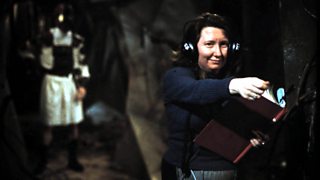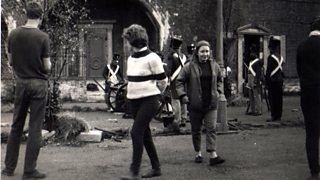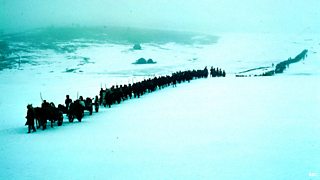Stars of Genome: Margot Hayhoe
Tagged with:

Margot Hayhoe in studio TC6
joined the �������� in 1964 as secretary in �������� Enterprises – she then progressed to the Drama Serials Department where she worked up the ladder from Assistant Floor Manager to Associate Producer. She worked in Doctor Who, EastEnders, Silent Witness, Man in the Iron Mask, War and Peace and many other �������� productions. She left the staff in 1994 and worked as a freelancer until 2005 when she retired for production work – she occasionally works as a background artist.
What was your first job in the ��������? My first job was acting in the children’s drama which was transmitted live from Lime Grove. It was telerecorded then transmitted again in April. I also appeared in Jack in the Box, Women of Troy, The Common Room, The Lady from the Sea and Champion Road for the �������� plus Cool for Cats, Emergency Ward 10 and The Lonely World of Harry Braintree for ITV amongst others. These were whilst I was still at my school,The Arts Educational.
Were you ever mentioned on the Radio Times magazine? Or is there any particular magazine you have kept as souvenir? I have never been interviewed for the Radio Times, only had my name listed in the casts of the above productions. I have kept the front covers of the Radio Times for the programmes I worked on as part of the production team, such as Prince Regent, War and Peace, plus many others. I also kept the supplement that came for War and Peace.
How do you use �������� Genome? And have you found any particular programme episode you are fond of? I sometimes look to to jog my memory of which actors were in certain series. I was particularly fond of any of the Francis Durbridge serials which always had wonderful cliff-hanger end of episodes!

"When finding locations, the variety of places I have been to has added to my education: inside prisons, mortuaries, council flats then stately homes, hospitals, court rooms, the working end of crematoriums, factories, dock yards and airports."
Can you share any special memories you have of the programmes and features you worked in? It is very difficult to pick out any special memories from Doctor Who and many of the other productions I worked on, as they mostly have all been memorable. However a Dr Who I did with Patrick Troughton called gave me the chance to fly in a helicopter for the first time. As we took off from a cliff edge to go down to the beach, I screamed as I watched the earth disappear from beneath my feet which encouraged the pilot to swerve around, very exciting.
Another memorable moment was on a serial with Frank Finlay, when we were filming a scene on the Isle of Wight that involved convicts in chains. These 20 or so actors were costumed and made-up in Portsmouth and I had to get the ferry tickets and march the men on board with their chains clanking away to get them to the location.
Trudging 14 times up and down St, Michael's Mount in a day on is seared into my brain as is hiding in cars to cue the drivers on Z Cars before the days of walkie-talkies.

A scene from War and Peace
On we had a thousand Yugoslav soldiers for several days and the organisation involved in getting them ready and into position was impressive.
Filming in the centre of Bern for which involved closing the streets for a night shoot; Filming on in Switzerland and France was a challenge, especially the beach scenes with strong winds blowing away the parasols and having to reschedule due to the rain.
Shooting Old Men at the Zoo with wild animals was interesting, plus having to find enough male extras prepared to have their bottoms exposed for injections as part of one scene shot in a disused biscuit factory near Hereford.
Trying to shoot London street scenes for was problematical as it was supposed to be deserted of any moving traffic. I enjoyed filming in Bath on as to see the actors in period costumes in the actual places in the book was a delight.
When finding locations, the variety of places I have been to has added to my education: inside prisons, mortuaries, council flats then stately homes, hospitals, court rooms, the working end of crematoriums, factories, dock yards and airports.
Working with the Visual Effects on makes one a bit blasé about body parts and post mortems!
How important do you think it is to preserve the history of TV and radio listings? I think it is very important to preserve the history of TV and Radio listings to show future generations the breadth and level of productions of the past. Looking at the pages in the 1950s and comparing them with the present day listings, shows how trivial much of today's output has become. It is also a great reference source.